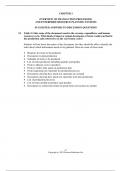Exam (elaborations)
solution manual Accounting Information Systems Romney Steinbart Summers Wood 15th edition
- Course
- Institution
Solution Manual Accounting Information Systems Romney Steinbart Summers Wood 15th edition - Updated Complete Solution Manual with Answers
[Show more]



